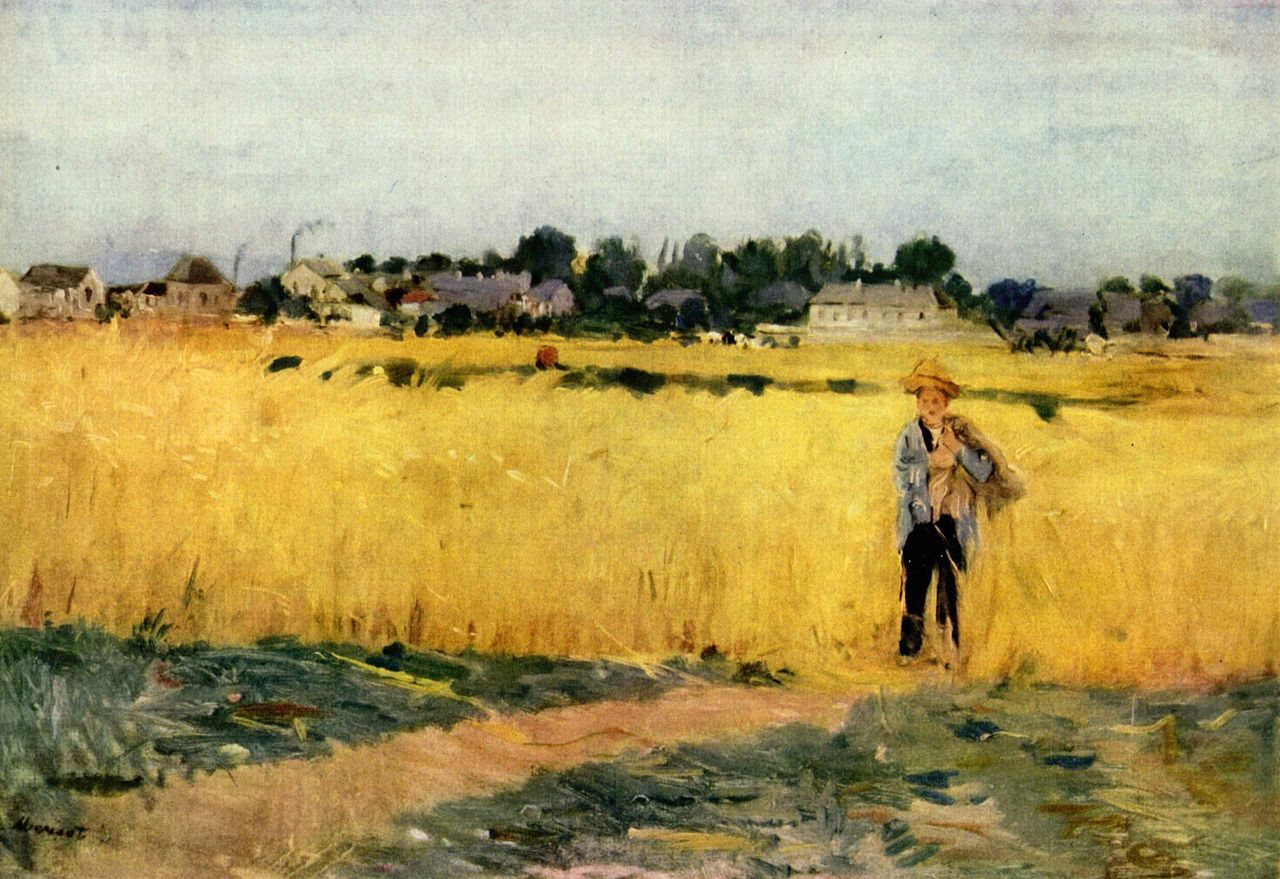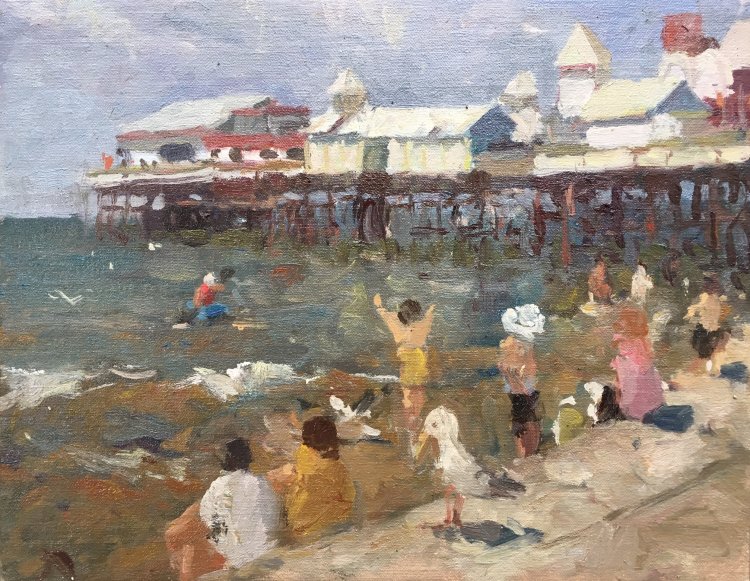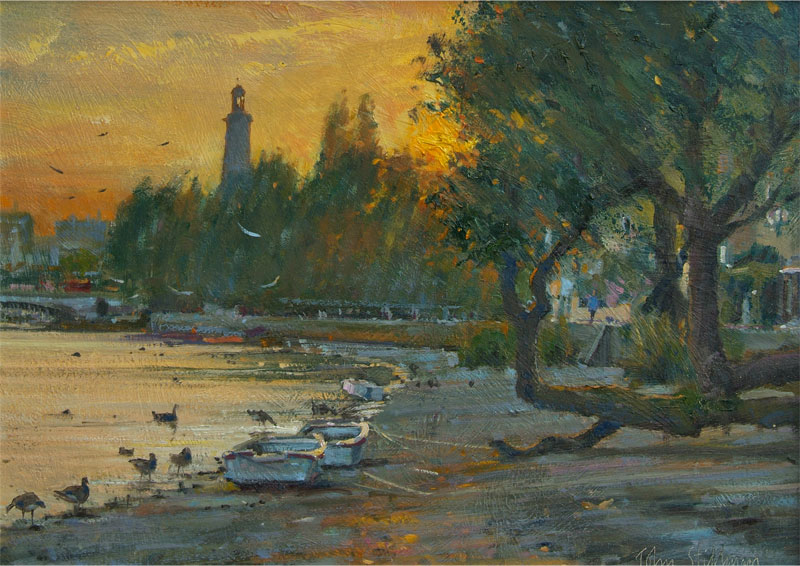As it’s been 130 years since the first British Impressionist Exhibition, we decided to revisit the Impressionist movement: what the themes were, the techniques that were used, and how the work was received. Looking at contemporary artists it is clear how many have been influenced by the Impressionists and use part of their approach in a modern way. This article also gives tips on how an artist can paint with this approach.
Above image: End of the Day Strand On The Green, John Stillman RSMA, 7 x 10 cm

Dans les blés, circa 1875
Berthe Morisot
Oil on canvas, 47 x 69 cm
Contemporary Impressionism: Painting Light Lives On
Contents
The Formation of Impressionism
Modern Impressionism Compared to Traditional Impressionism
Key Techniques of Impressionist Painting
Key Materials Used for Creating Impressionist Paintings
The Formation of Impressionism
The first exhibition of Impressionist work took place in April 1874, and at the time, they were considered ridiculous. But shortly after, they were seen as groundbreaking and now many of their views and techniques are taken as the mainstay of painting. Most people know the names of the main Impressionists (Monet, Renoir, Pissarro, Sisley, Cézanne, Berthe Morisot, Edgar Degas). And their work and approach is still increasingly popular with collectors and artists alike.

Girls Running, Walberswick Pier, 1888-94
Philip Wilson Steer
Presented by Lady Augustus Daniel, 1951
During the first exhibition, the term ‘Impressionist’ was coined to be derogatory. The art dealer Paul Durand-Ruel was unable to even pay the artists the agreed sums due to lack of collectors. And when several French Impressionists were staying in Britain their work barely sold. However, by the time of the first English Impressionist exhibition in 1889, the term Impressionist had become synonymous with modern life, spontaneity, independence, and the future of art. James McNeill Whistler brought many of the then solidified Impressionist techniques to Britain. He showed them to his pupils Walter Richard Sickert and Wilson Steer, who then promoted the approach in England through creating the New English Art Club.

The Camden Town Murder, or What Shall We Do For the Rent?, c.1908 – c.1909
Walter Sickert
Oil on canvas, 25.6 x 35.6 cm

Nude Reclining Striped Cotton 1
Michael Alford
Oil on board, 14 x 22 cm
Modern Impressionism Compared to Traditional Impressionism
An Impressionist approach is still favoured by many British painters working today. But, has the intention of Impressionism changed in its modern form? It was revolutionary at the time because it did away with the hard lines and clear forms that the art world had made mandatory, and instead relied on rapid brushstrokes and colour. This is no longer revolutionary so does it change the nature of the work?

Painter in the Shade
Roger Dellar RI, ROI, PS
12 x 12 cm
Some modern artists follow an Impressionist approach that hasn’t really changed in over 130 years. They work predominantly outdoors, focus on light, and work spontaneously to describe a moment. This means their work has similar themes and intent to the original Impressionists. However, while Impressionism was revolutionary at its inception it is now seen as traditional and part of the institution, meaning modern ‘Impressionists’ cannot be viewed as rebellious. A perfect example of how equivalent groups to the Impressionist communities are still thriving is the plein air groups the Northern Boys and the British Plein Air Painters, both of whom work predominantly outdoors and use some techniques that can be seen as Impressionist.
Lois Griffel’s book Painting the Impressionist Landscape builds and further looks at contemporary Impressionist painting compared to the original Impressionist paintings and describes how to mimic an Impressionist working style.

White dahlias
Haidee-Jo Summers
Oil painting on panel, 16 x 12 cm

The Seine at Lavacourt, 1880
Claude Monet
Oil on canvas, 98.4 cm x 149.2 cm
Key Techniques of Impressionist Painting
Some of the key features of Traditional Impressionism are in play in modern work as visible throughout this post. There tends to be slightly less optical mixing now as the abundance of per-mixed colours has made it redundant as a necessity while working outdoors. But many artists still opt to use optical mixing as it’s visually alluring.
- They focused on the effect of light, especially at dawn or dusk and at the golden hour.
- Distinctive fast brushstrokes rather than delicately painted details
- Thick application of opaque, often unmixed or only slightly mixed colours, using optical mixing to create other colours (this article explains the premise)
- Use of bright or highly pigmented paint to make the work vivid
- A heavy reliance on using complementary colours to define subjects rather than an over-reliance on greyscale values and harsh details
- They painted mainly outdoors or in situ rather than in the studio from sketches
- Chose ordinary scenes as subject matter
- Spontaneity featured heavily with the work being mainly unplanned and seeking to capture a moment, not meticulous detail

Central Pier canoeist
Adam Ralston
Impressionist Painting Techniques has further details and visual tests on how to achieve an Impressionist style or incorporate Impressionist techniques.

Adam Ralston working plein air
Key Materials Used for Creating Impressionist Paintings
Then as now, in order to produce an impression of a scene with true atmosphere the Impressionist worked outside rather than in a studio (this was also partially why their work was accused by some of being ‘sketches’). This made it essential to have a proper plein air set up. The focus on colour to guide the eye instead of tonal form or strong lines meant purchasing highly pigmented, bright oils, or other colour was a must.

Towards Rialto, Nightfall
Michael Richardson
Oil on panel, 10 x 12 cm
We also sell brushes designed by Michael Richardson for plein air Impressionist work.

Bauernhof zum Höllenkaff, 1874
Alfred Sisley
Oil on canvas, 47 x 62 cm

Late afternoon by Albert Bridge
Roger Dellar RI, ROI, PS
Oil on board, 12 x 12 cm
Further Reading
Travel Brushes for Painting on the Go
Jackson’s Wentworth Table Box Easel Review
Plein Air Painting With Jackson’s Materials
Review of Jackson’s Plein Air Canvas Board Carriers
Shop Plein Air Painting on jacksonsart.com
This article was originally published on 17th April 2019 as Contemporary Impressionism: Painting Light Lives On


